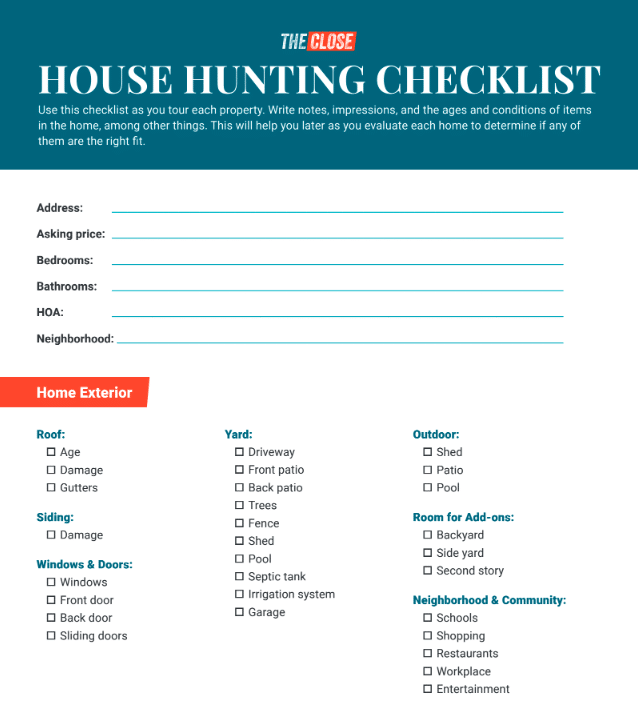You just landed a new buyer client. Congratulations! Now, you want to manage their expectations to get them started on the right foot. I’ve compiled a house hunting checklist you can download and share with your new clients so that you can answer their questions, set their expectations, and help them take action on their new home purchase.

Download Your Buyer House Hunting Checklist
Key Takeaways
- Examine key elements of the exterior and interior of the home to head off issues before making an offer.
- Coach your buyers to get pre-approved for a mortgage first so they’re ready to put in an offer with a pre-approval letter in hand.
- Encourage your clients to use an online calculator to estimate the price range they can afford for their new home.
- Share the house hunting checklist with your clients during the buyer questionnaire to answer questions before they come up and help them narrow their wish lists.
- Ensure your clients know the many pitfalls that can kill their home deal.
What to Include in Your House Hunting Checklist
As real estate buyers agents, we take what our clients, especially first-time buyers, know about real estate transactions for granted. But the truth is, they probably have a lot more questions than you think. Even if they’ve purchased a home before, they don’t do it every day.
You are the real estate agent—it’s your job to calm their fears and answer their questions, even the ones they don’t know they have yet. While following your real estate buyer agent checklist, discover as much as possible to prepare your clients for the journey ahead. Then, put that information together with the following house-hunting highlights to coach them.
Home Exterior
Buyers will probably have a what to look for when buying a house checklist. But when they pull up in front of a listing, they will get a “feel” for the home, and their reasoning will take a backseat. Here’s your chance to show off your expertise.
Home Interior
When your clients enter a listing, their first impression will come from an emotional place, whether they realize it or not. Many buyers will completely forget about the home search checklist they mapped out during your buyer presentation when they enter a home they fall in love with. It’s your job to ensure all the boxes get checked before any offers are considered.
- Water heater
- HVAC
- Lights & ceiling fans
- Refrigerator
- Oven
- Microwave
- Dishwasher
- Garbage disposal
- Toilets
- Faucets
- Lawn irrigation
- Pool pumps
- Washer & dryer
- Electrical
- Plumbing
- Irrigation (lawn)
- Gas
- Heating
- Air conditioning
- Pool

Tips to Give Buyers on the Homebuying Journey
When you’re across the table from your buyer clients, go over this homebuyer checklist to head off any pitfalls and let them know you’ve got them covered. Use the downloadable house hunting checklist, which includes this list for them to refer back to throughout the homebuying journey.
1. Do Research First
Tell your buyers to do some research ahead of time. Sit down and decide what things in the home are most important, what would be nice to have, and what are negotiable. Make a list of neighborhoods they’re interested in and what things are most important in the area where they’re looking. Make a priority list. This list will help you, as their agent, narrow down the search parameters and not waste time looking at homes that are not the right fit.
2. Be Realistic
Encourage your clients to decide early on what’s most important as they fill out the priority list. It’s important to manage their expectations. They can be picky about the home they want, but it’s important to point out that they will not find the “perfect” home because that doesn’t exist. Explain the three-sided triangle concept to them—the triangle has three sides: price, features, and location. You can find a home that meets two sides, but you cannot expect to find a home that meets all three criteria of the triangle. That’s a unicorn. 🦄
3. Get Finances in Order
Your clients may not realize that the first thing they need to do is shore up their financial situation. Have they saved enough money for a down payment? Have they checked their credit score? Do they have outstanding debts they need to clear up? These questions need answers before they start thinking about a huge purchase like a new home. Direct your clients to the online mortgage calculator to estimate their monthly payments to help them plan ahead.
4. Get Prequalified First
Once your clients have figured out their personal finances, the first thing any new homebuyer will need to do is talk to a lender and get prequalified. Your clients must know how much they can afford before looking for a new home. You don’t want to waste anyone’s time looking at homes out of your client’s price range. And they certainly don’t want to fall in love with a house they can’t afford.
5. Work With an Experienced Real Estate Agent
Working with an agent should be a given, especially for first-time buyers, who need to work with a professional who understands the ins and outs of a real estate transaction. Let buyers know that the process can be complicated and full of legal contracts and deadlines and that you are there to guide them through it. With the new court cases in the headlines and expectations for buyers paying for representation, you should go through the legalities of the buyer-broker agreement.
6. Choose a Moving Timeline
Your buyer clients need to establish a realistic timeline for moving. If they expect to move in the next 30 days, they will have difficulty making that happen. You can help them by giving them some parameters along with how long it takes to find and put in an offer on a home, have the offer accepted, and go through the process to get to the closing table. Don’t assume your clients will know it takes months to close on a new home. Prepare a Questions to Ask When Buying a House Checklist for them beforehand.
7. Know That There Is No Perfect Time to Buy
Your buyers may have concerns about the economy and the housing market. The truth is that there is no perfect time to buy or sell. Let your clients know that the time that works best for them is the best time. Soothe their fears and let them know that real estate has traditionally been an excellent investment, no matter how the economy is doing.
8. Choose a Neighborhood They Love
Your clients should ensure they don’t just shop for a house. The worst thing that could happen is they find a home they love but end up in a neighborhood that doesn’t fit their needs. Encourage your clients to check out the neighborhood they’re considering buying in. Does it have the conveniences and attractions they seek (e.g., schools, restaurants, parks, shopping, entertainment)? They may not find everything they want, but the neighborhood is definitely something to consider when shopping for their home.
9. Don’t Seek Too Much Advice
Your first-time homebuyers (and maybe even some second- or third-timers) will have family, friends, co-workers, and random strangers offer them homebuying advice. As their real estate agent, you should prepare them for the barrage of suggestions they will receive. While some good advice might be offered to your clients, much of it will be fear-mongering, outdated information, or even flat-out wrong. Encourage your buyers to seek counsel from those they trust most, but then be prepared to make their own decisions. After all, they’re the ones who will be living in the house, not their mothers-in-law.
10. Think Long-term
Real estate is an investment that can provide leverage against financial hardship. As a real estate professional, your job is to help your clients understand how real estate investing works. Are your clients just starting and looking for a starter home that they can upgrade after a few years? Or are they looking for a forever home?
Real estate is a long game, and it takes time to earn your money back, so ensure your clients understand they should stay in their new home for at least three years to earn enough equity to sell at a profit.

Don’t lose those clients you’ve worked so hard to land. The relationship shouldn’t end with the transaction. After all, 80% of referrals come from your past clients. Stay top of mind for the long term with an exceptional closing gift from HomeManager that will remind them of you all year.
11. Make Sure to Get a Home Inspection
No matter what type of home your clients buy, you should insist they invest in a home inspection. The home inspector’s job is to give the buyer a full-spectrum analysis of the home, checking for things they can’t necessarily see on the surface. They will check for foundation, roof, plumbing, and electrical issues to ensure the home is worth the money your clients are offering to pay. In essence, it’s a $600 investment in peace of mind.
12. Don’t Negotiate Yourself Out of a House
Many homebuyers, especially first-time homebuyers, believe you shouldn’t offer the asking price on a home. They have learned from somewhere that you should haggle to get the best price possible. To get your offer to stand out, keep things in perspective for them. If your clients love the home but are hesitant to offer the full asking price, you should guide them to keep what’s most important in mind—that they love the house. And they should understand that if they’re unwilling to pay the full asking price on the home, there’s most likely another buyer out there who is.
13. Factor in Some Repair Costs After Closing
Even a brand-new construction home won’t have everything your client wants when they close. Prepare them to spend a little money on final touches after they move in. There will inevitably be a few things that need to be addressed after closing. It is good to keep these final details in perspective as they get closer to their closing date. Ask them, “Is it important enough to keep you from closing?” If not, encourage them to make it their own once they move in. They can use the home viewing checklist from their home inspection as a plan of action.
14. Be Ready to Make a Decision
When your buyers see a house they love, ensure they’re ready to make an offer. Remind them shopping for a new home is like dating—ask, “Would you keep looking if you found your soulmate? Or would you stop and put a ring on it before someone else finds out how amazing this person is?” ensure they know if they hesitate, they could lose a home they love to another buyer. Don’t let fear keep them from going for it.
15. Bid Competitively
Don’t let your buyers try to outsmart the sellers, especially if they love the house. Long gone are the days when there were several options for buyers. Today, we live in a seller’s market, with tight inventory and high demand, more cash offers than ever, and the sellers have the most control. If your buyer clients love the house, they should make an offer reflecting that.
16. Keep Contingencies to a Minimum
Try to eliminate as many contingencies as possible before making any offers. Especially when your offer may be competing with others in a bidding war, work through any possible contingencies (financing, inspections, etc.) to draw up an offer that’s as attractive as possible to the sellers. You can even throw in a real estate love letter to the sellers to sweeten the deal and increase your chances of winning the bid.
17. Manage Expectations: No House Will Ever Be Perfect
The perfect house is a myth. It’s a unicorn. Remind your buyers of the three-sided triangle—there are three sides to the triangle: price, location, and features. Your clients can have two sides of the triangle, but you can never find a house with all three. Think of it this way: If the perfect house is a 10 and doesn’t exist, then if your buyers find a house that is an eight on that same scale, that’s probably going to be the right house for them. No house will have all the features and amenities they want. The questions to ask your clients are: “What are you willing to accept? What are you willing to concede?”
For example, assume the house your clients are considering has the perfect kitchen but no covered patio. Both were on their list, but one is more important than the other, and one can be added after closing. It’s essential to help your clients consider their priorities when deciding on their home purchase.

Mistakes to Avoid During The Home Search
Let’s get this out of the way: Buyers inadvertently kill their home purchases frequently because they don’t know what not to do. They may have a what to look for when buying a house checklist, but as their agent, you have a responsibility to inform them that making some of these mistakes during the homebuying process will kill their deal and any chance for a subsequent deal for a while. Share these common homebuyer pitfalls with your buyer clients.
Don’t change jobs.
If your clients are applying for a mortgage, it’s imperative they keep their current jobs to qualify for the loan. The loan underwriters will want to verify their income for the last few years and ensure it will be high enough to cover their payments. If they change jobs, the clock on their income starts over, making qualifying for the loan difficult.
Don’t take out any lines of credit or make big purchases.
When the loan underwriting process is underway, any changes to your client’s credit scores will affect their ability to qualify for their loan. That includes taking out large lines of credit or making large purchases, even in cash. While waiting for the final “clear to close” from the mortgage company, encourage them to hold off on doing anything that would set off alarm bells with their credit score.
Don’t get behind on any loans or utility payments.
Of course, you shouldn’t have to address this, but it happens more often than it should. While your clients are house hunting, ensure they stay on top of their bill payments. Late payments affect credit scores more frequently than a default on a credit card balance. And they happen quickly once a payment is late. Late payments on their credit report will drive their credit score down, possibly keeping your clients from qualifying for their home loans.
Ensure you save enough for closing costs.
Many first-time homebuyers underestimate how much money they need to save to close on a house. You might sit down with them and discuss how much it will take for them to buy a home, from the EMD to the home inspection to what they’ll need at the closing table.
Bringing It All Together
Most of us agree that the fun part of house hunting is the actual touring of homes. But if you want to ensure your clients complete a closing on their dream home, it’s up to you as their agent to guide them through the storm. It’s scary for buyers, even if it’s not their first time. Most of them probably have their questions to ask when buying a house checklist pdf handy before they ever contact you. Remember, we agents do this all the time, but buyers and sellers do it so infrequently that they don’t remember all the details from one transaction to the next. So, take the time to explain everything they need to know during the entire journey.
Did I leave anything out? Got a great strategy you use to keep your clients moving in the right direction? I’d love to hear about it! Drop us a line in the comments!










